
The W.H. Bickel Estate is a 2+1⁄2-story stone mansion built between 1928 and 1930 on the outskirts of Parkersburg, West Virginia. The 1,800-square-foot (170 m2) building has a rectangular main section and a wing to the East. It is known for its architecture and a ghost that reportedly haunts the area. The main house is rich with woodwork, including intricately inlaid walnut and maple floors with geometric patterns, wood mantels, partial wainscoting on all three floors, 15 light French doors on the first floor, solid maple arched doors on the second floor, built-in china cabinets, crown molding in all main rooms, and original finish wood casement windows with roll down screens and brass hardware. There are five gas fireplaces with marble or stone hearths in the main house and two staircases, including a circular walnut and maple main staircase. The ceilings are coved on the second and third floors, and the third floor contains a ballroom or “dance hall” stretching twenty eight feet.

This is a list of the National Register of Historic Places listings in Cabell County, West Virginia.
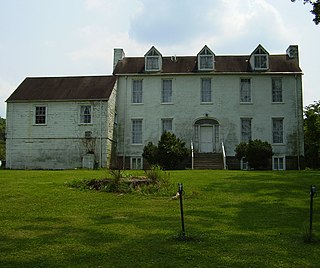
The Gen. Albert Gallatin Jenkins House — known historically as "Green Bottom" — is located on the east bank of the Ohio River about 7 miles north of Lesage, Cabell County, West Virginia.
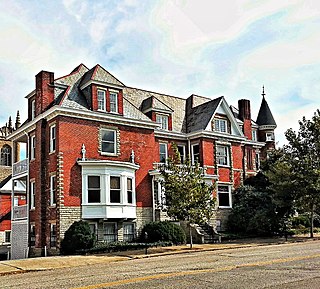
Campbell–Hicks House is a historic home located at Huntington, Cabell County, West Virginia. It was built in 1896, and is a 2+1⁄2-story, masonry dwelling in the Queen Anne style. It features a slender, two story cantilevered rounded tower. It also has a full front porch with a roof upheld by five sets of paired fluted columns with Ionic order capitals.

The Thomas Carroll House, also known as the Madie Carroll House, is an historic home located in the Guyandotte neighborhood in the city of Huntington, Cabell County, West Virginia. It is also known as one of the oldest structures in Cabell County. The original section of the house was built prior to 1810, and is believed to have arrived in Guyandotte by flatboat from Gallipolis, Ohio. The property was purchased by Thomas Carroll in March 1855 and remained under the ownership of his descendants until it was deeded to the Greater Huntington Parks and Recreation District on October 10, 1984, after the last tenant, Miss Madie Carroll's demise. It is one of the few houses in Guyandotte to survive the Civil War and even once was a church, an inn, and a home to many. During the Civil War the house was a safe haven for Union soldiers which is a rich history that the Madie Carroll House Preservation Society has spent the last few decades protecting and educating many on. As of today the house is owned and operated by the Madie Carroll House Preservation Society where they hold several events such as their annual Guyandotte Civil War Days. It is open to the public as a museum. It was listed on the National Register of Historic Places in 1973.
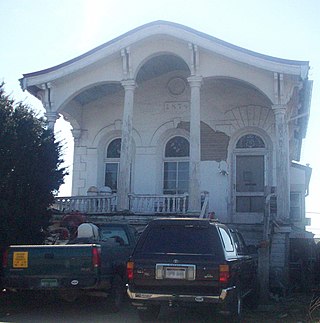
Harvey House, also known as the "Coin" Harvey House, is a historic home located at Huntington, Cabell County, West Virginia. It was built in 1874, and is a two-story dwelling reminiscent of houses in New Orleans. It features stained glass windows, a cast iron mantel, and a beamed ceiling in the dining room. It is most notable as the home of William Hope "Coin" Harvey.

Johnston-Meek House is a historic home located at Huntington, Cabell County, West Virginia. It is a two-story, brick Colonial Revival style dwelling with a hipped roof. The original section was built in 1832, with additions in 1838, 1923, and 1941. The 1923 Colonial Revival entrance portico and a number of other significant modifications were designed by local architect Sidney L. Day.
Kenwood, also known as the John A. Sheppard House, is a historic home located at Huntington, Cabell County, West Virginia. It was designed by the prominent West Virginia architect, H. Rus Warne, and built about 1910, and is a 2+1⁄2-story, rectangular, side gable house with flanking one-story, enclosed wings with flat roofs covered in green clay tile. The house measures approximately 100 feet long and 64 feet deep. It features an entrance portico with two story Tuscan order columns. The house is in the Classical Revival style with Greek Revival details. Also on the property is a contributing garage.
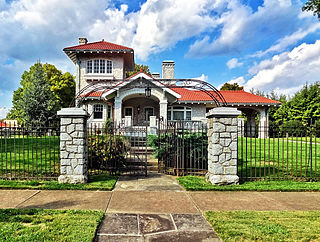
Prichard House is a historic home located at Huntington, Cabell County, West Virginia. It was built between 1921 and 1923, and is an Italian Renaissance-style residence. The house is built of gray North Carolina granite, topped by a Spanish tile roof, and sits on a reinforced concrete foundation. It features a distinctive two story tower and two roof garden chimneys. At the entrance to the property is the original wrought iron fence supported by granite pillars and iron gates. Also on the property are complementary and contributing guesthouse / garage and chicken house.
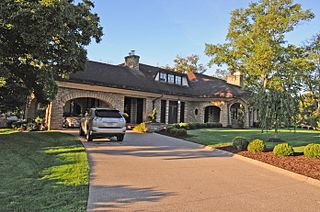
Ricketts House, also known as the Stevens Residence, is a historic home located at Huntington, Cabell County, West Virginia. It was designed in 1924, and built in 1925. It is a large stone dwelling with a complex, low pitched hipped roof punctuated by four large stone chimneys and with large overhanging eaves. The design is reflective of the Prairie School, with Tudor manor house influences. It is a significant and well-preserved work of the prominent Huntington architect, Levi J. Dean.

Huntington station, also known as Heritage Station, is a historic railroad depot located at Huntington, Cabell County, West Virginia. It was built in 1887, by the Huntington and Big Sandy Railroad, later the Baltimore and Ohio Railroad. The former passenger station is two stories and constructed of brick with a slate roof and two chimneys. The former baggage section to the east is one story. The front facade of the former passenger station features a bay window extending from the basement to the roof and dividing it into two sections. At the rear of the passenger station is the former freighthouse. The freighthouse is a brick building with a slate roof completed in 1890, and expanded in 1897, 1911, and 1916.
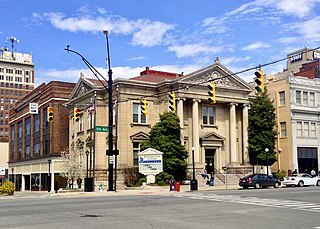
The Carnegie Public Library at Huntington, West Virginia, formerly also known as the Cabell County Public Library, is a historic library building located on the northeast corner of Fifth Avenue and Ninth Street. It was the first public library in the county. It served the community as a library until 1980, when a new library opened across the street. The building currently houses the Huntington Junior College.

Simms School Building is a historic elementary school building located at Huntington, Cabell County, West Virginia. It was built in 1919–1920, and is a two-story wire brick, steel frame building in the Classical Revival style. It has a square plan, with a center auditorium surrounded by a circular corridor with classrooms on three sides. The front entrance has a center colonnade with four round limestone Doric order columns capped with a limestone frieze and projecting cornice. The second floor features an open porch with wood columns and a projecting cornice topped by a clay tile mansard roof. An addition was completed in 1964. The school closed after 1980, and it now houses 20 apartment units for the elderly.

The West Virginia Colored Children's Home was a historic school, orphanage, and sanatorium building located near Huntington, Cabell County, West Virginia. It was the state's first social institution exclusively serving the needs of African American residents. The main structure, built in 1922–1923, was a three-story red brick building in the Classical Revival style. That building, located at 3353 U.S. Route 60, Huntington, West Virginia, was the last of a series of buildings that were constructed on the site. It was also known as the West Virginia Colored Orphans Home, Colored Orphan Home and Industrial School, the West Virginia Home for Aged and Infirm Colored Men and Women, and University Heights Apartments. It was listed on the National Register of Historic Places in 1997 but was demolished in 2011.
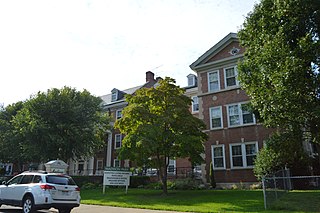
Foster Memorial Home is a historic sanatorium located at Huntington, Cabell County, West Virginia. It was built in 1924 to serve as a home for elderly widows. It is a three-story, dark red brick building with limestone trim in the Colonial Revival style.

Downtown Huntington Historic District is a national historic district located at Huntington, Cabell County, West Virginia. The original district encompassed 59 contributing buildings; the boundary increase added 53 more contributing buildings. It includes the central business district of Huntington and includes several of its municipal and governmental buildings. It contains the majority of the historic concentration of downtown commercial buildings. Located in the district are the separately listed Carnegie Public Library, Cabell County Courthouse, U.S. Post Office and Court House, and Campbell-Hicks House.

"Edemar", also known as Stifel Fine Arts Center, is a historic house and national historic district located at Wheeling, Ohio County, West Virginia. The district includes two contributing buildings and two contributing structures. The main house was built between 1910 and 1914, and is a 2+1⁄2-story, brick-and-concrete Classical Revival mansion with a steel frame. The front facade features a full-width portico with pediment supported by six Corinthian order columns. Also on the property are a contributing brick, tiled-roofed three-bay carriage barn/garage; fish pond; and formal garden. The Stifel family occupied the home until 1976, when the family gave it to the Oglebay Institute to be used as the Stifel Fine Arts Center.

Cobham Park, or Cobham Park Estate, is a historic estate located near Cobham, in Albemarle County and Louisa County, Virginia. The mansion was built in 1856, and is a rectangular 2+1⁄2-story, five-bay, double-pile structure covered by a hipped roof with three hipped roof dormers on each of the main slopes, and one dormer on each end. The house is an unusual example of ante-bellum period Georgian style architecture. It features front and rear, simple Doric order porches supported on square Ionic order columns. Also on the property are: two smokehouses, one brick and one frame, a frame dependency, and a simple two-story frame dwelling. It was the summer home of William Cabell Rives, Jr., (1825-1890), second son of the noted United States senator and minister to France William Cabell Rives.
Morris Memorial Hospital for Crippled Children, also known as Morris Memorial Nursing Home, is a historic hospital building located at Milton, Cabell County, West Virginia. It was built in 1936 by the Works Progress Administration as a hospital for children with polio. The modified U-shaped limestone building consists of a two-story central section, flanked by 1+1⁄2-story, Y-shaped wings. The central section features a domed and louvered cupola and a two-story portico. It has a T-shaped wing used as a school and a boiler house attached to the school wing by a hyphen. The hospital closed in 1960. It was subsequently used as a nursing home until 2009.
Freeman Estates is an unincorporated community in Huntington, Cabell County, West Virginia, United States.



















